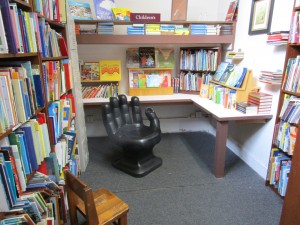The People in the Photo by Hélène Gestern
 My branch library is only a few blocks away, which makes it a key destination whether I’ve gone walking on the beach or biked over to the produce market. Did I mention that my branch is newly renovated with a view of the ocean and huge windows that let the sun stream through?
My branch library is only a few blocks away, which makes it a key destination whether I’ve gone walking on the beach or biked over to the produce market. Did I mention that my branch is newly renovated with a view of the ocean and huge windows that let the sun stream through?
Like a good bookstore, I can’t seem to pass by without popping in see what’s on the new arrivals shelf. I have a miniature library card on my key ring in preparation for any serendipitous book finds.
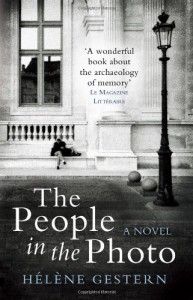 The People in the Photo was just such a find. The cover drew me in and the book was on it’s way home with me after this blurb:
The People in the Photo was just such a find. The cover drew me in and the book was on it’s way home with me after this blurb:
The chance discovery of a newspaper image from 1971 sets two people on the path to learning the disturbing truth about their parents’ pasts.
Parisian archivist Hélène takes out a newspaper advert calling for information about her mother, who died when she was three, and the two men pictured with her in a photograph taken at a tennis tournament at Interlaken in 1971. Stéphane, a Swiss biologist living in Kent, responds: his father is one of the people in the photo. Letters and more photos pass between them as they embark on a journey to uncover the truth their parents kept from them.
Epistolary novels are one of my favorite literary genres, but it’s a difficult writing style to pull off. Often it can be gimmicky, but when done well — riveting. Hélène Gestern has achieved the latter, all the more impressive as a translated French novel.
The story unfolds in a mixture of letters, emails and texts between Hélène and Stéphane as they uncover and exchange photos and revelations about their respective parents.
The characters evolve, as does their relationship, through their correspondence. At first they are reserved and cautious which we discover is due in large part to the secrets and unresolved feelings of their childhoods. But as they uncover new family histories, they also begin to share their feelings and soon develop a relationship they both believe will save them. But, perhaps, these discoveries are revealing a truth they don’t want to accept…
This is a quick read – not only because of its page-turning story line, but many pages contain only a short email or text. When I turned the last page of The People in the Photo, I turned back to the beginning to re-read parts of it again. I wanted to revel in the craft of the author – how carefully the characters are developed, the teasing bits of secrets revealed and the import of each piece of correspondence. In the end, I reluctantly returned this engaging novel to the library — but its impression remains.
Nature of the Beast by Louise Penny
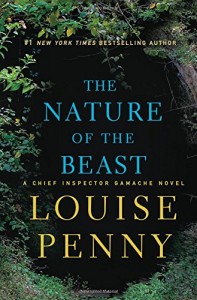 You may remember my previous post when I went to see Louise Penny at a local author appearance…and came away with a big author crush and her newest book, signed.
You may remember my previous post when I went to see Louise Penny at a local author appearance…and came away with a big author crush and her newest book, signed.
She gave a wonderful talk, answered questions (Myrna and her bookstore actually exist in Ms. Penny’s own village) and charmed everyone in attendance.
The next evening I made myself some bedtime tea and tore right in. Two nights later I closed the book and pondered these last two books —Long Way Home and this latest one.
Ms. Penny is clearly taking Gamache into a new direction. His life, after all, has changed. He is retired from the Sûreté and settled with his wife in the bucolic village of Three Pines. Gamache is content with retirement on the outside, but little by little we are learning his internal struggle with his new purpose in life. For Gamache, evil seems somehow – well all the more evil – when it invades his cozy existence in Three Pines. And it does just that in Nature of the Beast.
Evil doesn’t just invade, it gallops into his sanctuary of Three Pines with the murder of a village boy with a vivid imagination, a menacing missile launcher is discovered abandoned in the woods down a country lane — even the local drama group is putting on a play authored by a now-jailed serial killer — one of Gamache’s most horrifying past cases.
The dark threat prevails as Gamache and his former Sûreté colleagues work to untangle the secrets in this intertwined case. A villager with a hidden identity may have been involved in a My Lai type Vietnam massacre, Ruth is revealed to have a dark past, and the Whore of Babylon is an on-going theme, adding yet another layer of apocalyptic tension to the story line.
Most importantly, a nemesis is introduced — John Fleming – – the serial killer playwright, now in jail who taunts Gamache with penetrating insights. I suspect John Fleming will be back…
“I’m not the only prisoner in this room, am I?”, Fleming asks (Gamache), “You’re trapped in that village, you’re a middle aged man waiting out his days”
Then, there is the darkness of grief and Ms. Penny’s elegant writing brought tears to my eyes.
“..all my bones will dissolve and one day I’ll just dissolve. But it won’t matter, because there’s nowhere to go and nothing to do, no need of bones…”
I was fascinated by the depiction of Gamache’s new civilian role and the insightful writing depicts his internal conflict.
…(she) called Gamache ‘Monsieur’ rather than ‘Chief Inspector’. It was natural, healthy, true — but to Gamache it felt like having a tattoo scraped off.
Ms. Penny breathes humanity as fresh air into the tension — a long running Canadian miseries glues everyone to their TV sets and provides valuable alibis, gardening gives respite from grief, there is frustration with the village’s lack of cell or Wi-fi services and the bistro scenes made this reader raid the cupboard for that tin of hot chocolate mix.
I’m pleased with the development of Gamache’s wife, Reine-Marie and seeing her come to life as she moves beyond a supporting role to a key influence in Gamache’s thinking and actions.
I read Nature of the Beast with some incredulity, wondering how a huge “super gun” could be hidden in the woods so near the center of Three Pines and none of the long-time villagers remembers it being built or anything about it? Ten years ago the gun was strategically placed in Three Pines (close to the Vermont border) so that the Iraqis could bomb the U.S.? Really? After I finished the book, in the afterword, Ms. Penny reveals that the hidden missile launcher was based on true Canadian events — there really was such a gun and such a plan. Could have fooled me.
The story strained credibility even further when the final chapters depict a melodramatic race against time to save …whoops no spoiler here.
I kept thinking of the Murder She Wrote television series wherein Cabot Cove, Maine had a long running parade of far-fetched characters, seen-better-days actors and improbable story lines.
But just as I watched Jessica Fletcher to the bitter end (don’t judge), I won’t stop reading Ms. Penny’s books – ever.
The Gamache series is clearly going in a new direction and the last two books’ plots may often strain credibility — but her series still gift her readers with the some of the best writing, most elegant insights into art and humanity, and (not forgetting) the most idiosyncratic, loveable and interesting cast of characters in mystery fiction today.
True confessions, I have decided to re-read the series in order from the beginning. As Nature of The Beast refers back to Still Life – the first in this wonderful series.
I’m yours Ms. Penny, where ever you take me (see author crush above).
The Lost Garden, by Katharine Swartz
 You may be surprised (nay, perhaps shocked) at how little I read when traveling. All those flights, train trips, early evenings – one would think I’d be in book heaven…but afraid not. I gaze out at the scenery during train journeys holding my book (or kindle) unopened. I find myself catching up on missed movies during long flights and, as a typically tired tourist (all that walking, exploring, eating, navigating and translating) I fall asleep as soon as my head hits the pillow. So my reading falls by the wayside.
You may be surprised (nay, perhaps shocked) at how little I read when traveling. All those flights, train trips, early evenings – one would think I’d be in book heaven…but afraid not. I gaze out at the scenery during train journeys holding my book (or kindle) unopened. I find myself catching up on missed movies during long flights and, as a typically tired tourist (all that walking, exploring, eating, navigating and translating) I fall asleep as soon as my head hits the pillow. So my reading falls by the wayside.
I wanted an easy-going book for this most recent trip. Nothing too complicated with multiplying characters or, even worse, a family tree to keep straight. I knew while in Switzerland, I would be happily distracted and pleasantly tired. I would only be reading in short bits and pieces.
I’d been saving the The Lost Garden just for this trip. I eagerly awaited this historical novel of a hidden garden with secrets, a dual time-line (present day and just after WWII) and set in rural England. (I know, I’m boringly quite predictable.)
It also held charm because it brought to mind The Secret Garden one of my all-time favorite and cherished children’s books.
The Lost Garden is both a mystery and family saga set at Bower House, on the edge of a village church property with a hidden walled garden. In 1919, nineteen-year-old Eleanor Sanderson is grieving the death of her brother so her father hires a young gardener, Jack to restore the walled garden to comfort her. Eleanor falls for Jack especially once he reveals the garden to her. (I won’t give away the special garden he created – just know it’s magical.) Problems arise, secrets are kept and the garden is at the center of it all.
In the present day, Marin Ellis has taken on the custody of her sulky 15 year old half-sister, Rebecca. They move to Bower house to try and start a new life for themselves. They, too, are grieving the sudden accidental death of their parents. When Rebecca shows a spark of interest in the now decrepit walled garden, Marin hires Joss, a local gardener to help them restore the garden. Together, they uncover the garden’s past and its secrets – and again friendships and romance evolve around the lost garden.
I found the characters authentic and the setting just so darn dreamy (I want my own secret garden…). For those readers who want a fast moving plot and high drama – this is not a book for you, as The Lost Garden moves gently and slowly along. I found myself living with its characters, breathing in the rooms of the house and seeing the garden transformed in both time periods.
A purely pleasant read for total escape to a magical secret garden — some times that’s all you need.
Digital review copy provided by Lion Fiction via NetGalley.
The Signature of All Things by Elizabeth Gilbert
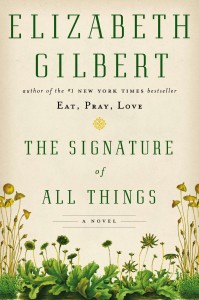 I was entranced by this book — just holding the beautiful hardback edition, with its botanical illustrations on the front and back flyleaves, gave me a little thrill. I was especially hooked by the storyline which follows a 19th century female botanist. I’ve long been fascinated with the early botanical illustrators who ventured into harsh climes to painstakingly draw and record plant specimens before the advent of photography. Add to this that I savored Ms. Gilbert’s Eat, Pray, Love — both the book and the film. So I was set – that magical feeling of embarking into a book that holds great promise.
I was entranced by this book — just holding the beautiful hardback edition, with its botanical illustrations on the front and back flyleaves, gave me a little thrill. I was especially hooked by the storyline which follows a 19th century female botanist. I’ve long been fascinated with the early botanical illustrators who ventured into harsh climes to painstakingly draw and record plant specimens before the advent of photography. Add to this that I savored Ms. Gilbert’s Eat, Pray, Love — both the book and the film. So I was set – that magical feeling of embarking into a book that holds great promise.
The Signature of All Things starts with the turn of the century birth of Alma Whittaker in January of 1800 to unorthodox and wealthy Philadelphia parents. On the first page we are lead back into Alma’s father’s beginnings — with this wonderful line:
How her father came to be in possession of such great wealth is a story worth telling here, while we wait for the girl to grow up and catch our interest again.
And so we learn of the world-spanning exploits of Henry Whittaker, thief turned botanist, in the late 1700s, where money follows Alma’s father around like a small, excited dog.
When we do meet Alma Whittaker some 50 pages in, she is being tutored by her parents in languages, acute observation and critical thought — they expect her, from a young age, to actively participate in their glittering intellectual dinner parties. She is cocooned within their estate — White Acres and the plant world — so beloved by her father. There is even a large indoor botanical garden patterned after George III’s own design.
Alma learned to tell time by the opening and closing of flowers. At five o’clock in the morning, she noticed, the goatsbeard petals always unfolded. At six o’clock, the daisies and globeflowers opened. When the clock struck seven, the dandelions would bloom. At eight o’clock, it was the scarlet pimpernel’s turn…
But, before long, Alma has descended into a prematurely sad, old woman. She is someone whose intellectual life is more important than any emotional one — she had too much to accomplish.
Whenever a beam of light shone through one of the tall, wavy-glassed windows, Alma would turn her face up toward it, like a tropical vine in one of her father’s botanical forcing houses, wishing to climb her way out.
Alma becomes an expert on mosses – her own botanical choice – as no one had ever studied their miniature ecosystems in depth. Alma publishes several highly-regarded botanical volumes on mosses during her years.
Moss grows where nothing else can grow. It grows on bricks. It grows on tree bark and roofing slate. It grows in the Arctic Circle and in the balmiest topics …moss is the first sign of botanic life to reappear on land that has been burned or otherwise stripped down to barrenness. The only thing moss needs is time, and it was beginning to appear to Alma that the world had plenty of time of offer.
Eventually Ambrose, an androgynous orchid illustrator, captivates her with his words and his art – and so she marries him — but alas, no romance for Alma.
For many years (even before Ambrose) Alma has found her sexual pleasure in a closet by herself – and we are given great detail of her “self-pleasuring” exploits. (Just as with the one and only porn film I watched, it quickly becomes painfully absurd.)
Alma lives well into her 9th decade, and her adventures, and those of her father, weave together the development of evolutionary thought during the mid-1800s. We learn how Captain Cook influenced Charles Darwin and we even get to meet A.R. Wallace who posited a theory of biodiversity concurrent with Darwin’s. Alma, too, comes upon her own theory of evolution via her moss studies, but Darwin beats everyone to the punch and garners all the fame. Ms. Gilbert fascinates in telling of these historical scientific discoveries, exploits and follies.
In an interview, Ms. Gilbert tells of years doing research and a 70-page outline. This exhaustive research and hard writing work clearly shines through in The Signature of All Things.
Where the novel falters is in the secondary characters who are introduced, one per chapter, as if even Ms. Gilbert was getting bored with her story and wanted new players. Alma’s adopted sister Prudence and their friend, Retta are meant to contrast with Alma’s cerebral character — but I found them unbelievable. The novel becomes a little un-tethered (as does Alma) once she leaves White Acres for Tahiti and Amsterdam where the complicated and dramatic relationships feel a bit contrived.
I found the novel at times strikingly beautiful — there is some jeweled writing — but also at time, tedious. Even though I merely scanned more than a few pages, I had to keep reading through to the end– as Alma’s story is ultimately fascinating and heartrending.
N.B. The title of the book refers to the theory that all life contains a divine code which was put forth by 16th century botanist, Jacob Boehme in his book De Signatura Rerum (The Signature of All Things).
The Bookstore Mouse by Peggy Christian
Just next door to the bookstore where I work/volunteer, there’s a children’s arts center with afternoon classes. When class is over the children often run (with parents trailing behind) into the store and quickly gravitate to our special children’s room/play area (click to see full size).
The parents can then, while keeping an eye on the little ones, slip over to the cafe and grab a coffee (they also sell wine and beer but I’ve never seen any parental indulgence –strong folks these parents).
Over the months, I’ve formed a friendship with one little girl who comes in every week after art class and her mom lets her buy a book or two. I’ll call her Penny because she is just as bright as a penny (no real names or photo for obvious reasons). Penny is a sturdy little girl, cowboy boots, a big wide grin, bangs I suspect she chops at herself, and an eclectic sense of colorful mismatched clothes. One can tell she must be a handful for parents and teachers alike — that combustive combination of open intelligence, imagination, impatience and enviable self-confidence – I liked her instantly.
Almost every week, she’ll find me in the store, just to say hello and to talk about things – what she did in art class (she once made me an origami bird), the books she’s reading, the books I’m shelving — Penny just loves to talk. But no idle chatter for Penny, she wants to know things — her conversations are real and her questions intense. Mostly we talk about books while her poor mother grabs a to-go coffee from the cafe. One week I pressed Blueberries for Sal into her hands promising her she would love it – she did. She can’t wait to read Harry Potter, but bemoans that she is still to young to read “such big books”.
++++++++++++++++++++++
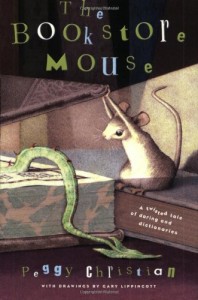 One day she brought this little book up to the register to purchase. Penny and I agreed it was a great find (the children’s books are not organized in any way, so the search is half the fun) and that it looked to be a very good book. I asked her to tell me about it once she’d read it because, of course, I love stories about bookstores and books.
One day she brought this little book up to the register to purchase. Penny and I agreed it was a great find (the children’s books are not organized in any way, so the search is half the fun) and that it looked to be a very good book. I asked her to tell me about it once she’d read it because, of course, I love stories about bookstores and books.
A couple weeks later Penny brought her book back and handed it me…saying “You can borrow this to read yourself. My Dad helped me, we had to look up lots of the words, but I think you will really like it – it’s soooooooo good, but I want it back, please, when you’re done.”
I know, I know, let’s have a collective moment of awwwww. I especially like that she was quite firm — SHE WANTS HER BOOK BACK – a fellow book hoarder in the making.
So during this week I read The Bookstore Mouse.
It’s the story of a mouse named Cervantes who lives in a bookstore and actually survives physically and emotionally on words – by eating them out of cookbooks, history books, novels. This little mouse has an impressive knowledge of words because the dictionary is his favorite book.
The words are typeset in differing fonts to show their meanings — anger, hunger, fright – as so…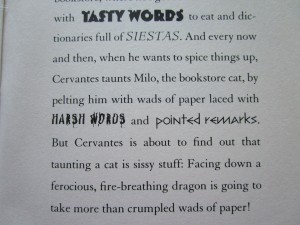
One day Cervantes, trying to escape the bookstore cat, jumps into a book and gets pulled into a story about a scribe who has to save a village from a dragon. The scribe has trouble finding the right words and Cervantes (and the child reading the story) tries to fill in just the right word. During the story they meet a giant who makes up very big words that mean nothing and we learn that big words can get in the way — smaller words often have more meaning.
I can see why Penny (and her Dad) had to look up words – here’s a sample of some of vocabulary I had to look up: prodigious, infandous, cacography — and then there are the made up words like nigmenog, whosits.
There is wordplay meant for very clever readers or adults. For example, the dragon is appropriately named Censor. Then there are underline worthy quotes such as this:
A page of print is like a secret passage that leads you to worlds so far away, you cannot imagine them until the magic of reading carries you there.
This is a tale where the words are the main character and these words need untangling and then become weapons, power and protection. This book will not only improve a young vocabulary, but deserves to be read aloud (while stopping to look up words together) with a bright young person in your life
Thank you Penny.
The Summer Guest by Justin Cronin
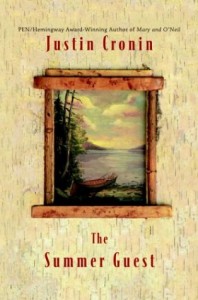 A question for my fellow book lovers: When you’ve just finished a truly moving book do you — like me, close the book, gaze lovingly at its cover, then exhale and hug it to your chest for a few moments? No? Really? OK it must be my own little book barmy quackery.
A question for my fellow book lovers: When you’ve just finished a truly moving book do you — like me, close the book, gaze lovingly at its cover, then exhale and hug it to your chest for a few moments? No? Really? OK it must be my own little book barmy quackery.
The Summer Guest was just such a hug-worthy book. An exceptionally beautiful novel which moved me to tears, laughter, and pure delight. The characters and setting were so real — so authentic, that when I’d lay the book aside — I had to take a moment to clear my head in order to resume my real life.
I’ve had this lovely book on my shelves for years (this is the 2005 paperback edition) and during a recent grey and foggy weekend I roamed my shelves looking for something “summery” to read…and chose this.
(Side note: This is how I justify my not-yet-read book hoarding collection — it is a true pleasure to wake up in my favorite PJ’s and with tea cup in hand, browse through my very own bookshelves and pick out just the perfect book for my mood and the San Francisco weather.)
However, The Summer Guest is not a lightweight summer beach book. This is a complex story of a family over time, children and their parents, love and loss — all told simply and beautifully .
In Mr. Cronin’s spare but expansive novel we begin in 1947, aboard a train chugging through a snowy Maine night and end up in 1997 on a tranquil late-summer evening lake, aboard an old wooden rowboat. Included in between — the living, loving and loss of a family united by a remote Maine fishing camp with an expansive fish-rich lake – “lovely in its pure beauty of having been forgotten”.
“the camp held a ninety-year lease from Maine Paper for two hundred acres rimming the lake to the north and west … I didn’t know exactly where the lines fell, but I didn’t have to. It was so much land it didn’t matter.”
There are the obligatory rutted roads through the deep Maine woods to get to the camp, the idyllic rustic cabins, with fireplaces and creaky porches. The days are filled with early morning coffee with the loons, the intricate symphony of fly fishing and home cooked evening meals in the communal dining room. You can smell the pine trees, baked beans and wood smoke.
The title and the main story line refers to Harry — a guest who has been coming to the camp for many years and is now an old and dying man. Different characters narrate each chapter and tell the past and present story from their individual viewpoints. So there’s also Jordan, a local loner who has become fishing guide and winter caretaker of the camp. Then there are the long-time owners of the camp, Joe and Lucy who have an enviable inner strength and warmth.
Mr. Cronin knows the area and has rendered the voice of his story through dry and acerbic Maine eyes:
“He gave me a curt nod from the chin, the North Woods equivalent of a full body hug.” and then this,
“this was an inbred town in northwest Maine where, as we said, half the people spoke French and the other half yelled.”
When Jordan, the local fishing guide takes out a group of big city lawyers, the author deftly captures the inevitable situation.
“By this point Bill had actually managed to get his fish under control and was thrashing around in the shallows, his rod hand held high over his head to keep the line tight while, with the other, he made unsuccessful, scooping lunges with his net. Done properly, this can be one of the most satisfyingly graceful moments in the sport, but in Bill’s case it was like watching a man trying to hail a taxi while simultaneously chasing a piece of blowing litter down the street.”
Mr. Cronin has precisely penned the words to express emotions we have all felt — from mournful sections which wrap the reader into the characters’ brave sadness and loss – to the exquisite joy of first love…
“…the thought of Kate was suddenly woven like a thread through everything, all that had ever happened to me, the clean smell of the pines and the lake and the memory of my lonely winters, the very turning world we stood on. They say that the moment your life appears before your eyes will be your last, but I’m here to say that it’s not so very different when you kiss a woman like Kate, whoever your Kate may be.”
The scene where the summer guests are dancing on the dock to Ella Fitzgerald is so beautifully told it will bring tears to your eyes.
Justin Cronin paints a beautiful picture of this remote Maine camp where the summers of deep woods and deep lakes come alive on the pages — “enough silence to let you hear the planet spin or make you mad if you thought too long about it.”
The Philadelphia Inquirer called The Summer Guest — “A work of art, Justin Cronin has written a great American novel.”
That captures it perfectly. I can only add it’s a must read (and a must keep on my shelves) novel. I highly recommend it.


